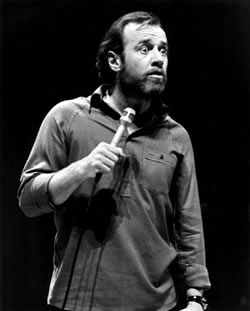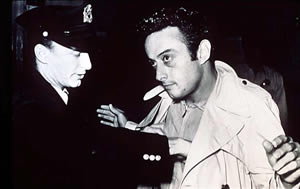GENE KRUPA’S FBI FILE: SURPRISE. SURPRISE! –UPDATE
Friday, July 11th, 2008You would think that Gene Krupa would have an FBI file that measures three feet in thickness, if only because of the unfortunate drug incident of 1943 and the reams of press surrounding it. Surprisingly, that is not the case. Some months ago, under the Freedom of Information Act, I petitioned the FBI and the U.S. Department of Justice to release any records in their files related to Gene.
There are 14 pages in Gene Krupa’s file. Twelve were released to me. The two pages not released had to do with medical records which would constitute an invasion of privacy, and some info that may or may not have disclosed a confidential FBI source.
The majority of the papers carry a date of February, 1949, specifically February 12, 14, 16, 18, 21 and 23. These records are pretty difficult for the lay person to decipher, but it appears that on or about February 12, 1949, the office of Canadian Immigration contacted the FBI for a background check on Gene. The “FBI Radiogram” from that date reads, “Gena (sic) Krupa…please advise by radio if any criminal record at Bureau. Subject described as well-known dance band leader, age 39, native of Chicago, present residence 10 Ritchie Drive, Yonkers. Report received subject possibly was charged in California with contributing to delinquency of a minor. No further particulars available.”
 (In all probability, Gene was playing at a venue called the “Armories” in Brockville, Ontario, which opened for business in 1948 The “rat” could have been someone at the Liquor Control Board there, in that liquor laws had been substantially relaxed in that year and there could have been concerned about having a wild-eyed “hophead,” i.e. Krupa–performing in a liquor-serving establishment. Just speculation.)
(In all probability, Gene was playing at a venue called the “Armories” in Brockville, Ontario, which opened for business in 1948 The “rat” could have been someone at the Liquor Control Board there, in that liquor laws had been substantially relaxed in that year and there could have been concerned about having a wild-eyed “hophead,” i.e. Krupa–performing in a liquor-serving establishment. Just speculation.)
The rest of the documents relating to this incident, which must have had to do with a gig in Canada with or without the whole band, detail the sad events of Gene’s January 19, 1943, the actual charges against him, his time in jail, fines paid, and just what charges were overturned.
For those interested in such things, the actual fine for the misdemeanor charge of contributing to the delinquency of a minor was $500. On May 18, he was sentenced to 90 days in jail but got out a few days early because of good behavior. However, on June 30, a jury found him guilty of a felony charge, “hiring and employing a minor to transport narcotics; marihuana cigarettes (sic).” He was sentenced to an unspecified term in San Quentin prison. Out on $5,000 during the appeal process, the felony charge was reversed by the California District Court of Appeals on June 30, 1944, because of double jeopardy.
On September 24, 1953, it again appears that Canada was suspicious of Gene, as a “Liaison Representative” from Ottawa, Ontario, seems to have asked the FBI for up-to-date dirt on the drummer. The reply, from none other than Ms. J. Edgar Hoover, reads, “Records of the FBI Identification Division reflect no reported arrests for Krupa since 1943.” Someone in Ottawa must have really had it in for Gene, as almost two years to the day later, the “Liaison Representative” asked about the dates and availability of fingerprint files within the FBI offices. The Bureau replied that there were no fingerprints taken after the 1943 incident.
Maybe this Canadian guy didn’t like be-bop. Or drum solos.
More interesting than the files themselves is what is not included. After all, in 1952, Krupa was the first American jazz performer to visit Japan, and during his during his Jazz at the Philharmonic days, he was all over Europe and points north and south. In the late 1950s, under Norman Granz’ aegis, he again toured Europe, and in the 1960s, went to South America and Israel, among other locations. And presumably, he was an annual visitor to the Frankfurt Music Fair, representing the Slingerland Drum Company, until he was too ill to travel around 1972.
Of all the cities and countries Gene visited in the world, only Canada caused a problem. Maybe someone knows the reason why.
There have been a few stories written in recent years, notably in Gene Lees’ “Jazzletter,” that suggest Gene was hounded by law enforcement officials, particularly during his Las Vegas tenures in the 1950s at the Frontier Hotel. Let the record finally show, that at least according to the FBI, he was not.
When I first went through all this paperwork and saw most of it dated 1949, my first thought was that some or all of this may have had to do with a messy drug situation that occurred within Gene’s big band in that year.
However, that incident happened in late July, five months after the Canadian nonsense. Although it was widely reported in the press at the time, and Gene was said to be very, very angry about it, what happened in Detroit on or about July 26, 1949, hasn’t been discussed for years. Since we’re on the subject of file openings, here’s what happened, courtesy of a Chicago Tribune article dated July 27, 1949.
It seems that three members of the Krupa band–guitarist Ralph Blaze, trombonist Herb Randel and trumpet John Bellow–were accused of possessing marijuana and later arrested at a downtown Detroit hotel. Presumably, the band was playing a theater or club in Detroit at the time. Police found Blaze in possession of two reefers and a pipe. The two members of the brass section were in for bigger trouble. They were found with cocaine, in addition to the pot, and ultimately pleaded guilty to violating federal narcotics regulations and were released on $1,000 bail pending sentencing. I don’t think Bellow or Randel did any actual time.
In addition to the drugs, Detroit police found three, 18-year-old girls in the hotel room. Two were from out of town and said they flew in to visit Randel and Bellow. The third was a home town girl who said she met Ralph Blaze “a week ago.” Blaze and the ladies were not charged with anything.
After leaving Krupa, Ralph Blaze had a long and successful career with Stan Kenton and many other west coast groups, and also established himself as a respected sculptor. He was active in the recording studio and in live performance into the early 1990s.
Herb Randel, a reliable section man, spent some seasons in Woody Herman’s 1950 to 1951 “Third Herd” after being relieved of duty by Gene (Woody had more tolerance for bad boys back then). Randel seems to have fallen off the radar screen after 1951,
John Bellow showed up in the trumpet section of a 1958 Charlie Barnet band and in a Quincy Jones-led studio group that backed Billy Eckstine in 1961. Tom Lord’s incisive discography, which lists Bellow as “Bello,” says he participated in 63 recording sessions from 1946 to 1964. After that, nothing.
Some good things happened in 1949, including some nice recordings for Columbia and Roy Eldridge’s happy return to the band, which lasted from February to October. I get the idea, however, that the Detroit incident, coupled with sad state of the band business in 1949, really helped sour Gene on the idea of keeping the large group together much longer.
The decision was almost made for him. In 1950, he lost his long-time Columbia Records contract and his switch to the RCA label was brief and not very productive. In the beginning of 1951, he cut down to a 12-piece crew. They sounded awful. Check out the JazzLegends.com CD entitled “Gene Krupa: London House 1964 and Cavalcade of Bands 1951” for an example.
In retrospect, it is simply incredible that Gene Krupa was able to keep a big band of any kind together until almost 1952. Benny, Woody, Les Brown, Dorsey and Basie gave up in 1950 (although all but Benny would ultimately re-form) and Ellington was barely hanging in there.
Gene would play, and play very well, in big bands again, on record and in person, but only for record sessions, special concerts or television shows. From 1952 until his death in 1973–21 years–this big band icon was a small group drummer.
Update and correction:
Our good colleague Mike Berkowitz, the marvelous drummer, conductor and leader of the wonderful “New” Gene Krupa Orchestra, has been kind enough to update us as to the whereabouts of trumpeter John Bello, who played on the 1949 Krupa band. Earlier in this column, I said I could find nothing on Bello beyond a 1964 record date.
This demonstrates the current limitations of the web as a research tool–and in this case, the current limitations of the researcher as well–especially when it applies to jazz.
As incredible as Tom Lord’s “Jazz Discography” is, how can researchers track a musician who played and recorded a whole lot of music that might have not been jazz?
Bello, by the way, is the correct spelling of his name, which has sometimes been listed as “Bellow.” He lived, according to Mike Berkowitz, in the Philadelphia/Atlantic City area for many years, and Mike actually used him on some band dates there. In earlier years, he also worked extensively with Maynard, Quincy Jones, in a number of Broadway pit bands, etc.
What is particularly astounding is that Bello was, for some years, Judy Garland’s lead trumpeter, having appeared on dates under the baton of Mort Lindsey, Bill LaVorgna and Howard Hirsch. Every Garland fan certainly has a copy of the famed, Carnegie Hall concert recordings. Lead trumpet player on that date: John Bello.
Our apologies to Bello, who lives in Florida and still plays with rehearsal bands here. And our thanks to Mike Berkowitz, who is, indeed, “extraordinaire.”





 Bruce and Carlin worked most of the jazz joints when there were such things, and both were busted for obscenity. Bruce was first arrested in 1961 at the Jazz Workshop in San Francisco for uttering a 10-letter word that referred to a sex act, Carlin’s run-in with the law occurred in 1972 at the Milwaukee Summerfest for his “Seven Words You Can Never Say On TV” routine. One of the words in Carlin’s act, by the way, was the very same word Lenny was busted for 11 years earlier.
Bruce and Carlin worked most of the jazz joints when there were such things, and both were busted for obscenity. Bruce was first arrested in 1961 at the Jazz Workshop in San Francisco for uttering a 10-letter word that referred to a sex act, Carlin’s run-in with the law occurred in 1972 at the Milwaukee Summerfest for his “Seven Words You Can Never Say On TV” routine. One of the words in Carlin’s act, by the way, was the very same word Lenny was busted for 11 years earlier. Like it or not, he changed the course of comedy, and virtually everything we hear today is an extension or modification of what Lenny Bruce did over 40 years ago.
Like it or not, he changed the course of comedy, and virtually everything we hear today is an extension or modification of what Lenny Bruce did over 40 years ago.
